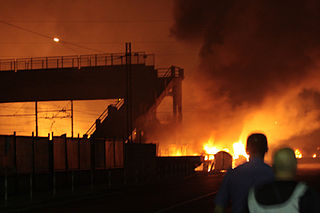Related Research Articles
The Ryongchŏn disaster was a train disaster that occurred on 22 April 2004 in the town of Ryongchŏn, North Korea, near the border with the People's Republic of China. At least 54 people were killed, including some Syrian scientists.
The Ufa train disaster was a railway accident that occurred on 4 June 1989, in Iglinsky District, Bashkir ASSR, Russian SFSR, Soviet Union, when an explosion killed 575 people and injured 800 more. It is the deadliest rail disaster during peacetime in Soviet/Russian history and the second-deadliest overall after the Vereshchyovka train disaster.
There have been many extremely large explosions, accidental and intentional, caused by modern high explosives, boiling liquid expanding vapour explosions (BLEVEs), older explosives such as gunpowder, volatile petroleum-based fuels such as gasoline, and other chemical reactions. This list contains the largest known examples, sorted by date. An unambiguous ranking in order of severity is not possible; a 1994 study by historian Jay White of 130 large explosions suggested that they need to be ranked by an overall effect of power, quantity, radius, loss of life and property destruction, but concluded that such rankings are difficult to assess.

The Thirsk rail crash occurred on 31 July 1967 at Thirsk, Yorkshire, England on the British Rail East Coast Main Line.
There have been a number of train accidents on the railway network of Victoria, Australia. Some of these are listed below.

The Viareggio derailment was the derailment and subsequent fire of a freight train carrying liquefied petroleum gas. It occurred on 29 June 2009 in a railway station in Viareggio, Lucca, a city in Central Italy's Tuscany region. Thirty-two people were killed and a further twenty-six were injured.

The Soham rail disaster occurred on 2 June 1944, during the Second World War, when a fire developed on the leading wagon of a heavy ammunition train. The wagon contained a quantity of high explosive bombs. The train crew had detached the wagon from the rest of the train and were drawing it away when the cargo exploded. The fireman of the train and the signalman at Soham signalbox were killed and several other people injured. The driver, Benjamin Gimbert, and fireman, James Nightall, were both awarded the George Cross for preventing further damage which would have occurred if the rest of the train had exploded.
The Kamensk-Shakhtinsky rail disaster occurred on August 7, 1987, at 01:30 in Kamenskaya station in the town of Kamensk-Shakhtinsky on the North Caucasus Railway in the Soviet Union when a freight train ran into the rear of a passenger train standing in the station, killing 106.
This article lists significant fatal, injury-only, and other accidents involving railway rolling stock, including crashes, fires and other incidents in the Australian state of South Australia. The first known incident in this list occurred in 1873 in Smithfield.
This is a list of significant railway accidents in Queensland, Australia.
This article is concerned with railway accidents occurring in Western Australia, where they are identified as fatal accidents, injury related accidents, or where infrastructure or rolling stock was damaged.

The Brandsen rail disaster occurred on March 8, 1981, in Brandsen, a town in Buenos Aires Province in Argentina, when a passenger train carrying 803 passengers collided head-on with a freight train, killing 34 and injuring another 74. The train crash was caused by points failure.
Arzamas I railway station is a major mainline railway station located in Arzamas, Nizhny Novgorod Oblast, Russia. It is a junction of Gorky Railway, 115 km from Nizhny Novgorod railway station. The station combines four routes out of Arzamas. It is an important junction, where the Nizhny Novgorod — Arzamas main line, and the railway lines to Kanash, Saransk and Murom diverge. It is approximately 2,4 km from the town center.

The Catterick Bridge Explosion occurred on 4 February 1944 in the railway sidings at Catterick Bridge station, on the Richmond Branch Line/Catterick Camp Railway in North Yorkshire, England. It killed twelve people and injured more than a hundred. The incorrect loading of explosives into railway wagons is believed to have been the cause, but because of wartime restrictions, reporting of the event was not as widespread as it would have been had the explosion occurred in peacetime.
The rail war began in different regions of Russia in the spring of 2022 after a similar rail war in Belarus.
References
- ↑ Taubman, Philip (June 6, 1988). "Soviet Freight Train Explodes, Killing at Least 68". New York Times. Retrieved August 18, 2015.
- ↑ Story by Daniil Turovsky, translated by Kevin Rothrock. Like a day of war 30 years ago, a train explosion ripped through the Soviet city of Arzamas, and locals to this day believe it was part of a plot to destroy the USSR. Meduza , 04.06.2018